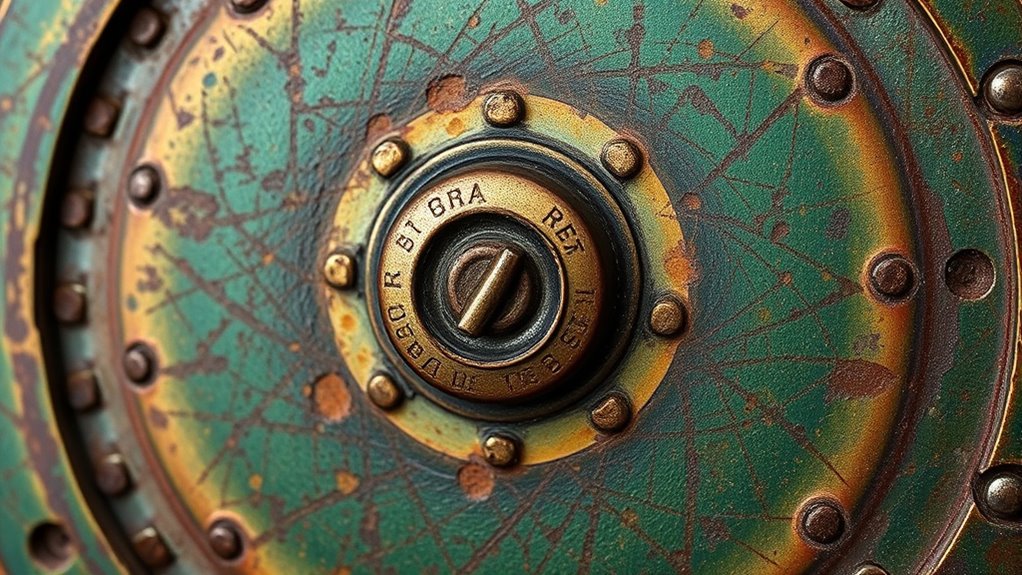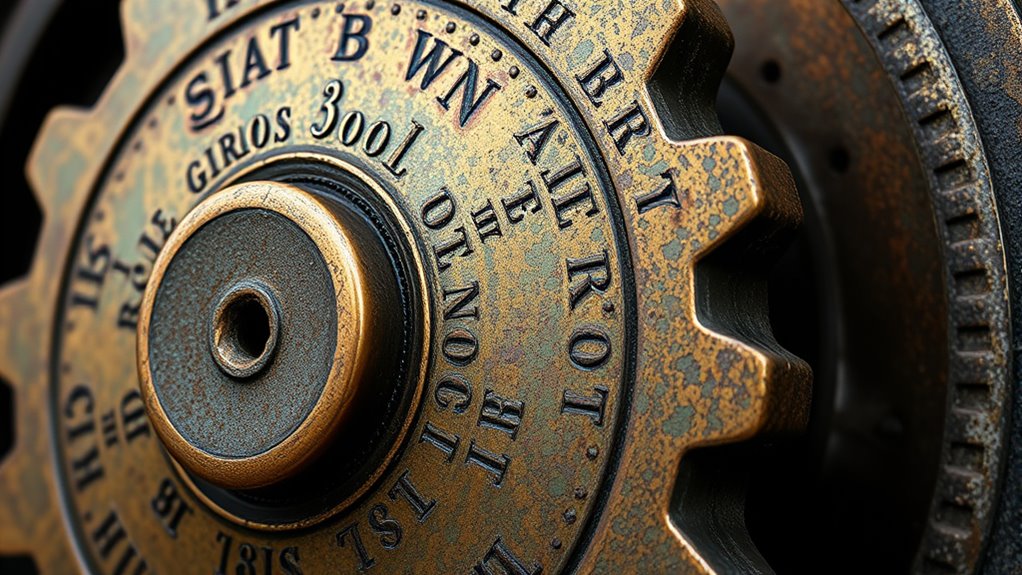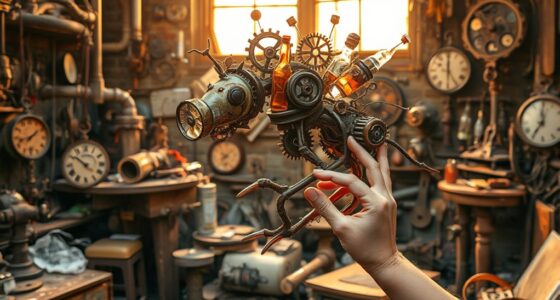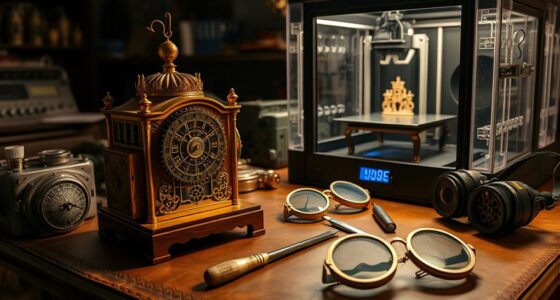To master the patina for a steampunk look, start by controlling oxidation and applying chemical treatments like liver of sulfur or ferric chloride to your metals. Experiment with solutions on scrap pieces first to find the ideal color and texture. Protect your work with sealants once you’re happy with the result. By understanding these techniques and safety precautions, you’ll turn plain metals into character-rich, aged surfaces. Keep exploring to reveal even more creative finishing options.
Key Takeaways
- Use controlled chemical treatments like liver of sulfur or ferric chloride to create vibrant, aged patinas on metals.
- Test all oxidation and chemical processes on scrap pieces to achieve consistent, desired results.
- Apply sealants or waxes after patina development to preserve and prevent unwanted further oxidation.
- Carefully follow safety protocols, including protective gear and ventilation, when handling chemical solutions.
- Understand the aging process to guide oxidation and chemical treatments for authentic steampunk aesthetics.

Achieving a beautiful patina isn’t just about aging; it’s about understanding and guiding the process to enhance the character of your piece. When you’re aiming for that authentic steampunk look, mastering oxidation techniques and chemical treatments becomes essential. These methods allow you to control the way your metal ages, creating unique textures and colors that tell a story. Instead of leaving your metal to age naturally, you actively intervene, pushing it toward a desired aesthetic.
To start, familiarize yourself with oxidation techniques. These involve exposing your metal to specific environments or substances that accelerate natural rusting or tarnishing. For example, applying vinegar, lemon juice, or saltwater can produce initial oxidation, but to achieve a more controlled and vibrant patina, you’ll want to use chemical treatments. These treatments are specially formulated solutions designed to produce precise colors and textures on metals like copper, brass, or steel. For instance, applying liver of sulfur to copper creates deep blues and greens, while ferric chloride can give steel a rich, rusty appearance. The key is to experiment with concentrations and application methods—brushes, sprays, or dips—to see how your metal responds.
Experiment with chemical treatments like liver of sulfur and ferric chloride to create vibrant, controlled patinas on metals.
Safety is *essential* when working with chemical treatments. Always wear gloves, eye protection, and work in a well-ventilated area. Follow the manufacturer’s instructions carefully, as some solutions are potent and require proper handling. Before applying any chemical treatment to your main piece, test it on a small, inconspicuous area or a scrap piece of metal. This way, you can gauge how the metal reacts and adjust your approach accordingly. Patience plays a *significant* role here; rushing the process can lead to uneven or undesirable results. Additionally, understanding the chemical reactions involved can help you better predict how your metal will develop its patina over time.
Once you’ve achieved the desired patina, you can lock it in with a clear sealant or wax to preserve the look and prevent further oxidation. Remember, the beauty of a patina isn’t just in its initial appearance but in how it continues to develop over time—if you choose to let it do so naturally. But with chemical treatments, you have a powerful tool at your disposal to create a consistent, vibrant, and character-rich surface that embodies the steampunk aesthetic perfectly. By mastering these techniques, you gain control over your metal’s aging process, transforming plain materials into stories etched in corrosion and color.
Frequently Asked Questions
How Long Does the Aging Process Typically Take?
The aging process can vary depending on your approach, but it usually takes from a few hours to several days. When you use chemical application, you can speed up or slow down the patina development, while environmental factors like humidity and temperature also influence the timing. Keep an eye on your project and adjust the conditions or chemical treatments to achieve the desired aged look efficiently.
What Safety Precautions Are Necessary When Working With Chemicals?
Imagine you’re aging copper for a steampunk project. You should always wear protective gear like gloves and goggles to prevent skin and eye contact. Guarantee proper ventilation safety by working in a well-ventilated area or using fume extraction devices. These precautions help you avoid chemical inhalation or burns, making your creative process safe and enjoyable. Always follow the manufacturer’s instructions for handling chemicals to prevent accidents.
Can Patina Be Removed or Reversed Easily?
You might wonder if patina can be easily removed or reversed. While chemical removal can strip away the aged look, it’s not always straightforward and may require specific solutions. DIY reversal is possible but can be tricky, as some chemicals might damage the metal or cause uneven results. Always test on a small area first, and use proper safety precautions to avoid mishaps.
Is There a Way to Control the Color of the Patina?
It’s interesting how sometimes, by chance, you discover that chemical color control allows you to influence the patina’s hues. You can control the color of the patina by adjusting the chemicals you use, creating specific shades or effects. While natural patina variations happen over time, applying controlled chemical treatments lets you achieve consistent, desired tones, giving your metalwork a personalized, authentic steampunk aesthetic.
Which Metals Respond Best to Aging Techniques?
You should know that different metals respond best to aging techniques based on oxidation speed and metal compatibility. Copper and brass age beautifully because they oxidize quickly, creating rich patinas, while steel and aluminum react more slowly. To control the aging process, consider the metal’s natural tendencies and how it interacts with various solutions. This way, you can achieve consistent, vibrant colors suited to your steampunk aesthetic.
Conclusion
As you master the art of aging metals, remember that patina isn’t just about appearance—it’s a story etched in time. Some believe that genuine aging can’t be replicated, but your hands and patience prove otherwise. By experimenting and embracing imperfections, you create authentic, mesmerizing pieces. Ultimately, the true beauty of a patina lies in its ability to reflect history and character, reminding you that beauty often emerges through the passage of time.








